
Bethesda is a town and community on the River Ogwen and the A5 road on the edge of Snowdonia, in Gwynedd, north-west Wales. It is the fifth-largest community in Gwynedd.

The Penrhyn Quarry Railway was a narrow gauge railway in Caernarfonshire, Wales. It served the Penrhyn quarry near Bethesda, taking their slate produce to Port Penrhyn, near Bangor. The railway was around six miles (9.7 km) long and used a gauge of 1 ft 10+3⁄4 in.

George Sholto Gordon Douglas-Pennant, 2nd Baron Penrhyn, was a landowner who played a prominent part in the Welsh slate industry as the owner of the Penrhyn Quarry in North Wales.

The Penrhyn quarry is a slate quarry located near Bethesda, North Wales. At the end of the nineteenth century it was the world's largest slate quarry; the main pit is nearly 1 mile (1.6 km) long and 1,200 feet deep, and it was worked by nearly 3,000 quarrymen. It has since been superseded in size by slate quarries in China, Spain and the USA. Penrhyn is still Britain's largest slate quarry but its workforce is now nearer 200.

Richard Bell was one of the first two British Labour Members of Parliament, and the first for an English constituency, elected after the formation of the Labour Representation Committee in 1900.

Edward Gordon Douglas-Pennant, 1st Baron Penrhyn, was a Scottish landowner in Wales and Jamaica, and a Conservative Party politician. He played a major part in the development of the Welsh slate industry.
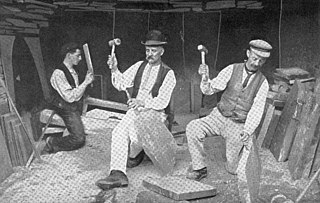
The existence of a slate industry in Wales is attested since the Roman period, when slate was used to roof the fort at Segontium, now Caernarfon. The slate industry grew slowly until the early 18th century, then rapidly during the Industrial Revolution in Wales until the late 19th century, at which time the most important slate producing areas were in northwest Wales. These sites included the Penrhyn Quarry near Bethesda, the Dinorwic Quarry near Llanberis, the Nantlle Valley quarries, and Blaenau Ffestiniog, where the slate was mined rather than quarried. Penrhyn and Dinorwig were the two largest slate quarries in the world, and the Oakeley mine at Blaenau Ffestiniog was the largest slate mine in the world. Slate is mainly used for roofing, but is also produced as thicker slab for a variety of uses including flooring, worktops and headstones.

The Hendre-Ddu Tramway was a 1 ft 11 in narrow gauge industrial railway built in 1874 in Mid-Wales to connect the Hendre-Ddu slate quarry to Aberangell station on the Mawddwy Railway. It consisted of a main line 3+1⁄2 miles (5.6 km) long and several branch lines and spurs serving other quarries, local farms and the timber industry.

Dinorwic quarry is a large former slate quarry, now home to the Welsh National Slate Museum, located between the villages of Llanberis and Dinorwig in Wales. At its height at the turn of the century, it was the second largest slate quarry in Wales, after the neighbouring Penrhyn quarry near Bethesda. Dinorwic covered 700 acres (283 ha) consisting of two main quarry sections with 20 galleries in each. Extensive internal tramway systems connected the quarries using inclines to transport slate between galleries. Since its closure in 1969, the quarry has become the site of the National Slate Museum, a regular film location, and an extreme rock climbing destination.
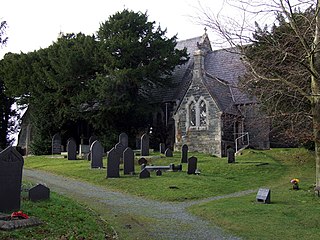
Tregarth is a village near Thomas Telford's A5 London to Holyhead road between the town of Bethesda and the city of Bangor in Gwynedd, north Wales. It is in Llandygai Community. It had a population of over 1,300 as of the 2011 census..
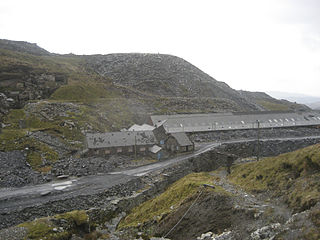
Maenofferen quarry is a major slate quarry in the town of Blaenau Ffestiniog, north Wales and one of the major users of the Ffestiniog Railway. It continues to produce crushed slate on a limited scale under the ownership of the nearby Llechwedd quarry.
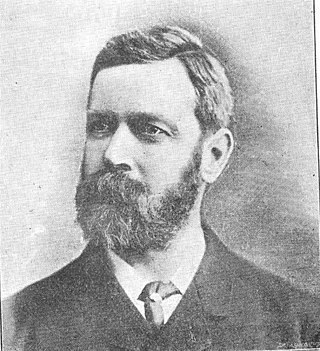
William John Parry was a Welsh businessman, politician and author. Parry was a leading voice in a range of activities and causes, and was the first general secretary of the North Wales Quarrymen's Union.

Cilgwyn quarry is a slate quarry located on the north edge of the Nantlle Vale, in North Wales. It is one of the earliest slate quarries in Great Britain, being worked as early as the 12th century. King Edward I of England was reputed to have stayed in a house roofed by Cilgwyn slates, during the Welsh wars of independence. It is one of the major slate quarries in the Nantlle Valley area.
The North Wales Miners' Association was a trade union representing coal miners in Wales.

The Prince Llewellyn quarry was a slate quarry that stands on the west side of the Lledr Valley, ENE of Dolwyddelan. It was worked from around 1820 to 1934.

The Penmachno quarry was a slate quarry near Cwm Penmachno, Conwy, North Wales. It was directly below the Rhiwbach Quarry. It was worked between 1818 and 1962.

The Cwm Ebol quarry was a slate quarry about 1 mile (1.6 km) north west of the village of Pennal in Mid Wales. It operated from about 1860 to about 1906. It was the last Welsh slate quarry connected only to a trans-shipment point instead of directly to a railway.
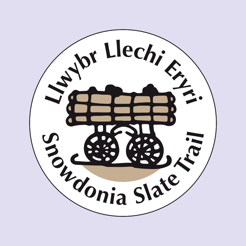
Snowdonia Slate Trail is a long distance footpath, running 83 miles (134 km) as a circular route around Northern Snowdonia through the UK`s latest World Heritage Site, starting from Bangor. It passes through the main areas and heritage sites associated with the slate industry, and also through some of its major landscapes.

Gilfach Ddu are a series of well preserved Grade I listed industrial buildings built to serve the Dinorwic slate quarry near Llanberis in Caernarfonshire, North Wales. The workshops are a complex of repair and maintenance buildings, that were built in 1870 to build and maintain the machinery used in the quarry. The complex includes saw sheds, patternmaking shops, a foundry with copula, blacksmiths shops, fitting shops, stores, engine sheds, a canteen, the chief engineers house, a hand operated crane and two waterwheels which provided the site with its power. Since 1972 the buildings have housed the National Slate Museum.
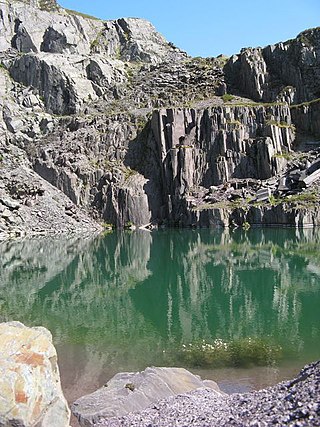
Alexandra quarry was a slate quarry in North Wales, on the slopes of Moel Tryfan in north Gwynedd. It was part of one of the major slate quarrying regions of Wales, centred on the Nantlle Valley during the 19th and 20th centuries. Output increased when a connection to the North Wales Narrow Gauge Railways branch to Bryngwyn was created. It closed in the late 1930s, but was subsequently amalgamated with the Moel Tryfan quarry, and production continued until the 1960s.




















